Annotated Bibliography on Strategic Human Resource Management
VerifiedAdded on 2023/06/13
|9
|2278
|311
AI Summary
This annotated bibliography provides an overview of the latest research on strategic human resource management. It covers topics such as HRM practices, employee turnover, corporate sustainability, and e-HRM technology. The bibliography includes articles and books by renowned scholars in the field.
Contribute Materials
Your contribution can guide someone’s learning journey. Share your
documents today.
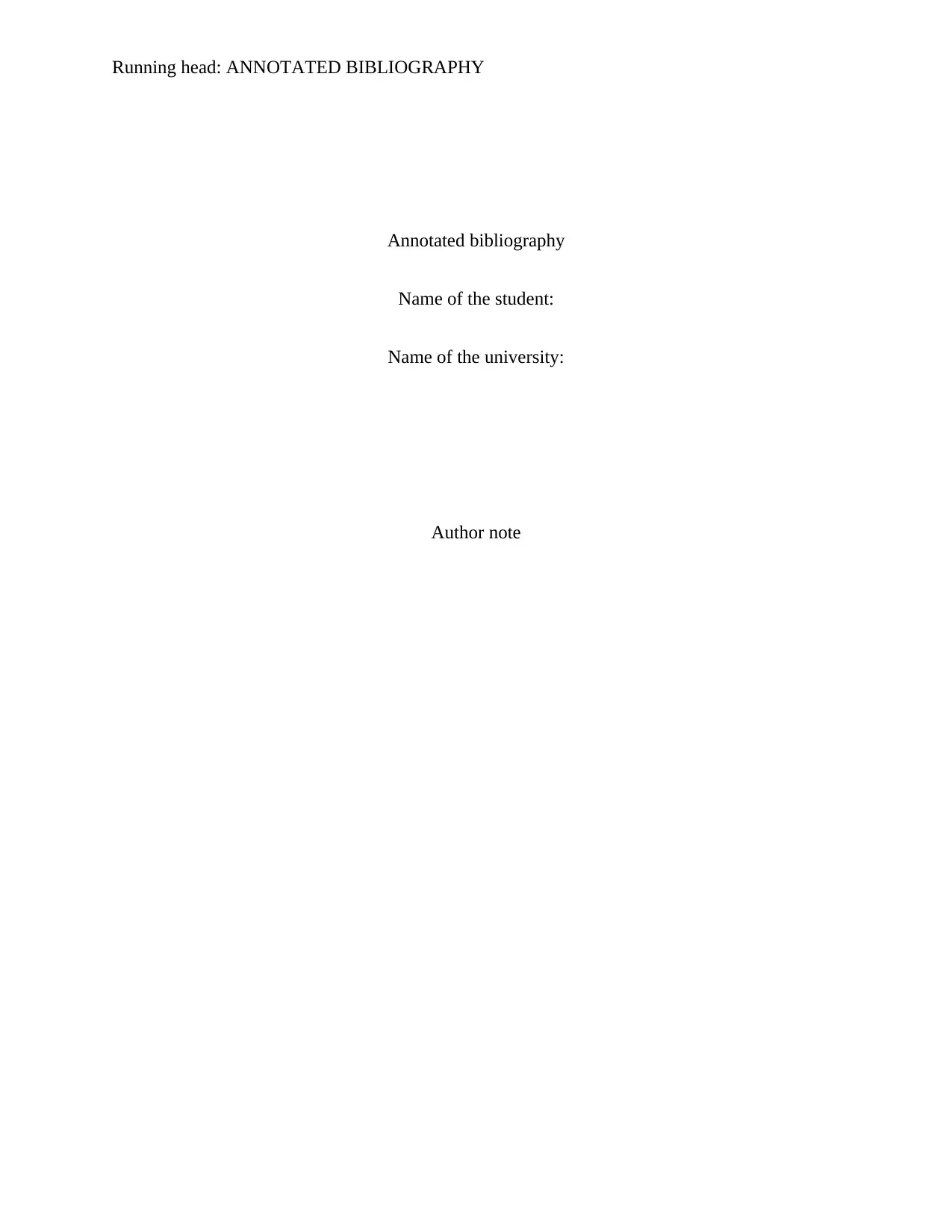
Running head: ANNOTATED BIBLIOGRAPHY
Annotated bibliography
Name of the student:
Name of the university:
Author note
Annotated bibliography
Name of the student:
Name of the university:
Author note
Secure Best Marks with AI Grader
Need help grading? Try our AI Grader for instant feedback on your assignments.
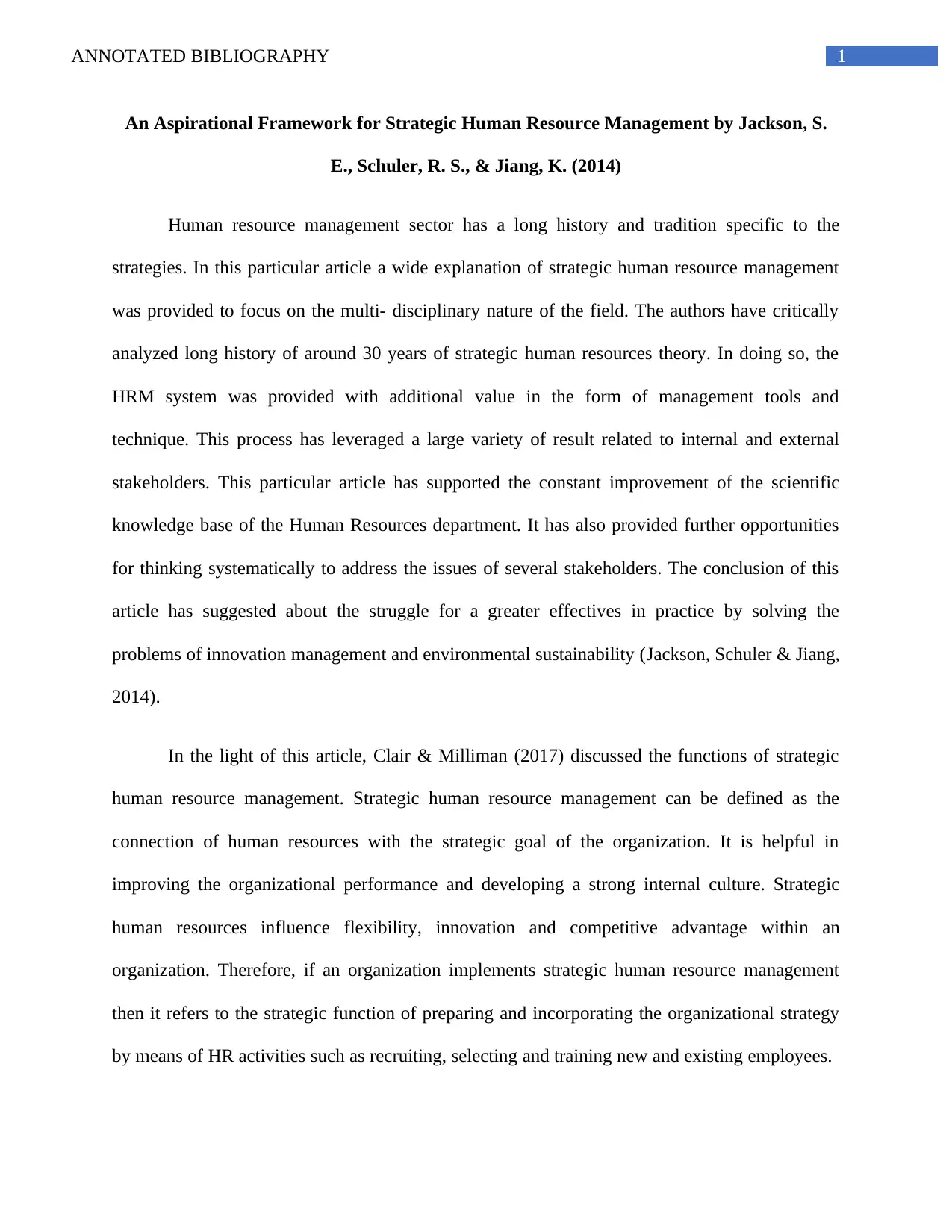
1ANNOTATED BIBLIOGRAPHY
An Aspirational Framework for Strategic Human Resource Management by Jackson, S.
E., Schuler, R. S., & Jiang, K. (2014)
Human resource management sector has a long history and tradition specific to the
strategies. In this particular article a wide explanation of strategic human resource management
was provided to focus on the multi- disciplinary nature of the field. The authors have critically
analyzed long history of around 30 years of strategic human resources theory. In doing so, the
HRM system was provided with additional value in the form of management tools and
technique. This process has leveraged a large variety of result related to internal and external
stakeholders. This particular article has supported the constant improvement of the scientific
knowledge base of the Human Resources department. It has also provided further opportunities
for thinking systematically to address the issues of several stakeholders. The conclusion of this
article has suggested about the struggle for a greater effectives in practice by solving the
problems of innovation management and environmental sustainability (Jackson, Schuler & Jiang,
2014).
In the light of this article, Clair & Milliman (2017) discussed the functions of strategic
human resource management. Strategic human resource management can be defined as the
connection of human resources with the strategic goal of the organization. It is helpful in
improving the organizational performance and developing a strong internal culture. Strategic
human resources influence flexibility, innovation and competitive advantage within an
organization. Therefore, if an organization implements strategic human resource management
then it refers to the strategic function of preparing and incorporating the organizational strategy
by means of HR activities such as recruiting, selecting and training new and existing employees.
An Aspirational Framework for Strategic Human Resource Management by Jackson, S.
E., Schuler, R. S., & Jiang, K. (2014)
Human resource management sector has a long history and tradition specific to the
strategies. In this particular article a wide explanation of strategic human resource management
was provided to focus on the multi- disciplinary nature of the field. The authors have critically
analyzed long history of around 30 years of strategic human resources theory. In doing so, the
HRM system was provided with additional value in the form of management tools and
technique. This process has leveraged a large variety of result related to internal and external
stakeholders. This particular article has supported the constant improvement of the scientific
knowledge base of the Human Resources department. It has also provided further opportunities
for thinking systematically to address the issues of several stakeholders. The conclusion of this
article has suggested about the struggle for a greater effectives in practice by solving the
problems of innovation management and environmental sustainability (Jackson, Schuler & Jiang,
2014).
In the light of this article, Clair & Milliman (2017) discussed the functions of strategic
human resource management. Strategic human resource management can be defined as the
connection of human resources with the strategic goal of the organization. It is helpful in
improving the organizational performance and developing a strong internal culture. Strategic
human resources influence flexibility, innovation and competitive advantage within an
organization. Therefore, if an organization implements strategic human resource management
then it refers to the strategic function of preparing and incorporating the organizational strategy
by means of HR activities such as recruiting, selecting and training new and existing employees.
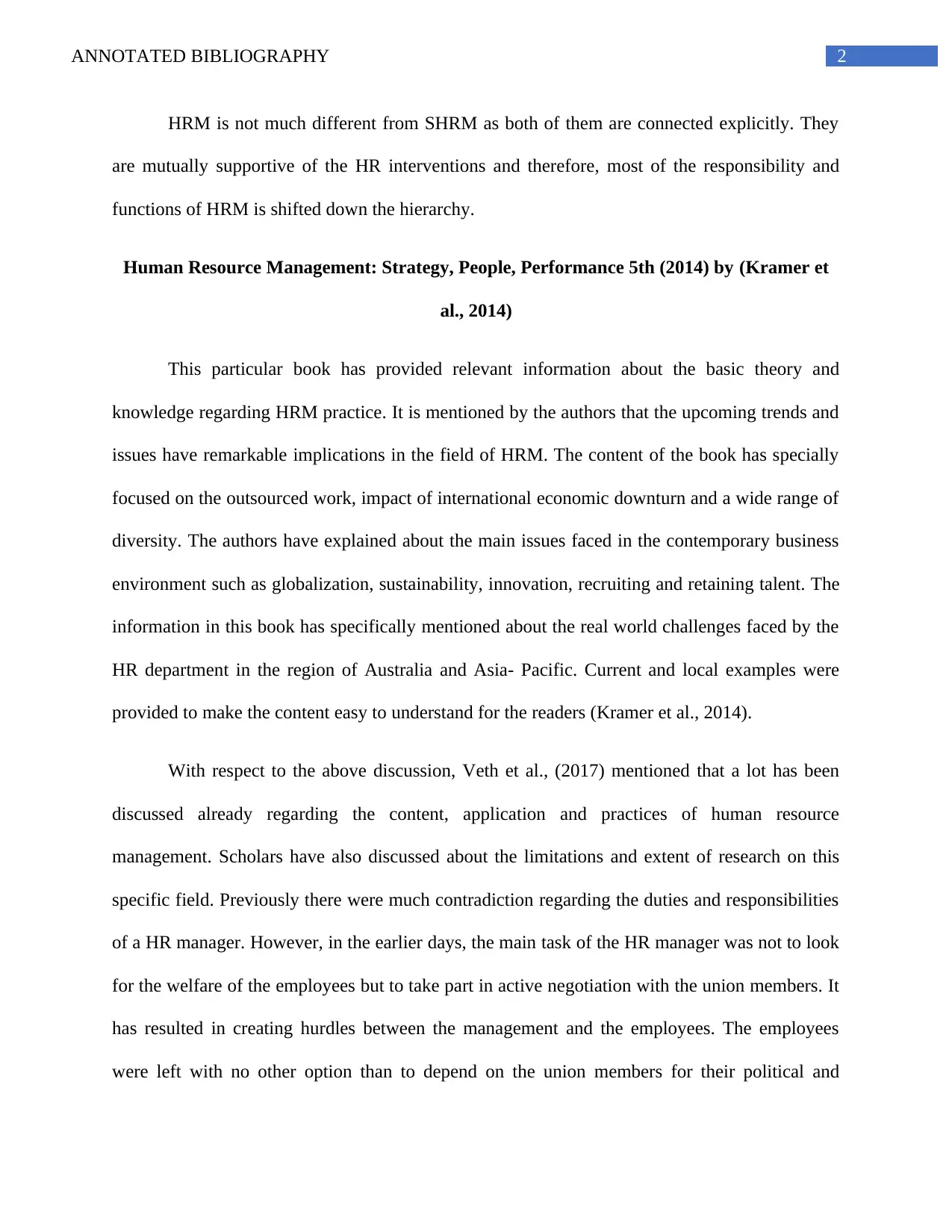
2ANNOTATED BIBLIOGRAPHY
HRM is not much different from SHRM as both of them are connected explicitly. They
are mutually supportive of the HR interventions and therefore, most of the responsibility and
functions of HRM is shifted down the hierarchy.
Human Resource Management: Strategy, People, Performance 5th (2014) by (Kramer et
al., 2014)
This particular book has provided relevant information about the basic theory and
knowledge regarding HRM practice. It is mentioned by the authors that the upcoming trends and
issues have remarkable implications in the field of HRM. The content of the book has specially
focused on the outsourced work, impact of international economic downturn and a wide range of
diversity. The authors have explained about the main issues faced in the contemporary business
environment such as globalization, sustainability, innovation, recruiting and retaining talent. The
information in this book has specifically mentioned about the real world challenges faced by the
HR department in the region of Australia and Asia- Pacific. Current and local examples were
provided to make the content easy to understand for the readers (Kramer et al., 2014).
With respect to the above discussion, Veth et al., (2017) mentioned that a lot has been
discussed already regarding the content, application and practices of human resource
management. Scholars have also discussed about the limitations and extent of research on this
specific field. Previously there were much contradiction regarding the duties and responsibilities
of a HR manager. However, in the earlier days, the main task of the HR manager was not to look
for the welfare of the employees but to take part in active negotiation with the union members. It
has resulted in creating hurdles between the management and the employees. The employees
were left with no other option than to depend on the union members for their political and
HRM is not much different from SHRM as both of them are connected explicitly. They
are mutually supportive of the HR interventions and therefore, most of the responsibility and
functions of HRM is shifted down the hierarchy.
Human Resource Management: Strategy, People, Performance 5th (2014) by (Kramer et
al., 2014)
This particular book has provided relevant information about the basic theory and
knowledge regarding HRM practice. It is mentioned by the authors that the upcoming trends and
issues have remarkable implications in the field of HRM. The content of the book has specially
focused on the outsourced work, impact of international economic downturn and a wide range of
diversity. The authors have explained about the main issues faced in the contemporary business
environment such as globalization, sustainability, innovation, recruiting and retaining talent. The
information in this book has specifically mentioned about the real world challenges faced by the
HR department in the region of Australia and Asia- Pacific. Current and local examples were
provided to make the content easy to understand for the readers (Kramer et al., 2014).
With respect to the above discussion, Veth et al., (2017) mentioned that a lot has been
discussed already regarding the content, application and practices of human resource
management. Scholars have also discussed about the limitations and extent of research on this
specific field. Previously there were much contradiction regarding the duties and responsibilities
of a HR manager. However, in the earlier days, the main task of the HR manager was not to look
for the welfare of the employees but to take part in active negotiation with the union members. It
has resulted in creating hurdles between the management and the employees. The employees
were left with no other option than to depend on the union members for their political and

3ANNOTATED BIBLIOGRAPHY
financial benefit. They had to follow the leadership of the union against their will, thus leading to
low productivity. In order to overcome this problem, a set of new HRM goals were set for
encouraging the employees to participate for a better organizational performance.
Addressing the Issues on Employees’ Turnover Intention in the Perspective of HRM
Practices in SME by Long, C. S., Ajagbe, M. A., & Kowang, T. O. (2014)
The authors of this article have countered the discussion of the previous articles about the
critical roles required to play by the HR managers and business owners. They have explained
that the managers need to put their utmost effort in resolving the issues related to employee
turnover and the primary focus was put on the small and medium organizations. The paper has
explicitly revealed the effect of HR practices that is able to amend the negative influence on the
organization resulting from high employee turnover. The key points of this article included
compensation and benefit for the employees, training, and employee relationship and
performance management. Information has been gathered from existing literature on similar kind
of issues to put a strong impact on this research paper (Long, Ajagbe & Kowang, 2014).
To continue the discussion on the contemporary issues faced by HRM Kaliguiri (2017),
has mentioned that the preconceived notions of the HR managers need to be changed regarding
their role. This has been considered as the main issue faced by the HR managers and officials.
Most of them think that the primary function of HR is to seek and recruit new talent. However,
the new idea is that the major HR activities revolve on the retention of existing talent. Employees
are the assets of an organization therefore, they need to be nourished with proper training and
equipments for improvement. The employees need to realize that their presence is valued in the
organization. It is also a challenge for the HR department to finds the suitable individual with
financial benefit. They had to follow the leadership of the union against their will, thus leading to
low productivity. In order to overcome this problem, a set of new HRM goals were set for
encouraging the employees to participate for a better organizational performance.
Addressing the Issues on Employees’ Turnover Intention in the Perspective of HRM
Practices in SME by Long, C. S., Ajagbe, M. A., & Kowang, T. O. (2014)
The authors of this article have countered the discussion of the previous articles about the
critical roles required to play by the HR managers and business owners. They have explained
that the managers need to put their utmost effort in resolving the issues related to employee
turnover and the primary focus was put on the small and medium organizations. The paper has
explicitly revealed the effect of HR practices that is able to amend the negative influence on the
organization resulting from high employee turnover. The key points of this article included
compensation and benefit for the employees, training, and employee relationship and
performance management. Information has been gathered from existing literature on similar kind
of issues to put a strong impact on this research paper (Long, Ajagbe & Kowang, 2014).
To continue the discussion on the contemporary issues faced by HRM Kaliguiri (2017),
has mentioned that the preconceived notions of the HR managers need to be changed regarding
their role. This has been considered as the main issue faced by the HR managers and officials.
Most of them think that the primary function of HR is to seek and recruit new talent. However,
the new idea is that the major HR activities revolve on the retention of existing talent. Employees
are the assets of an organization therefore, they need to be nourished with proper training and
equipments for improvement. The employees need to realize that their presence is valued in the
organization. It is also a challenge for the HR department to finds the suitable individual with
Secure Best Marks with AI Grader
Need help grading? Try our AI Grader for instant feedback on your assignments.
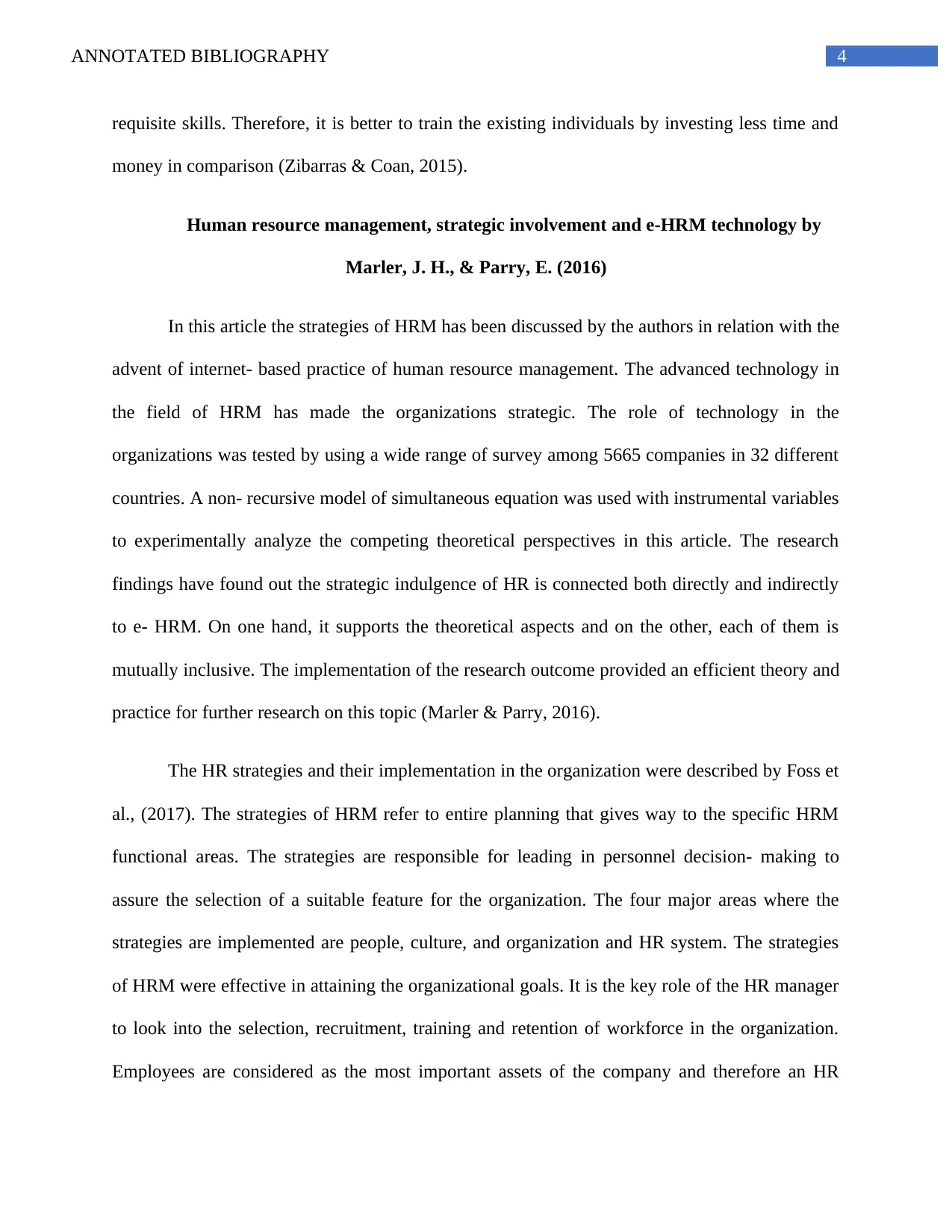
4ANNOTATED BIBLIOGRAPHY
requisite skills. Therefore, it is better to train the existing individuals by investing less time and
money in comparison (Zibarras & Coan, 2015).
Human resource management, strategic involvement and e-HRM technology by
Marler, J. H., & Parry, E. (2016)
In this article the strategies of HRM has been discussed by the authors in relation with the
advent of internet- based practice of human resource management. The advanced technology in
the field of HRM has made the organizations strategic. The role of technology in the
organizations was tested by using a wide range of survey among 5665 companies in 32 different
countries. A non- recursive model of simultaneous equation was used with instrumental variables
to experimentally analyze the competing theoretical perspectives in this article. The research
findings have found out the strategic indulgence of HR is connected both directly and indirectly
to e- HRM. On one hand, it supports the theoretical aspects and on the other, each of them is
mutually inclusive. The implementation of the research outcome provided an efficient theory and
practice for further research on this topic (Marler & Parry, 2016).
The HR strategies and their implementation in the organization were described by Foss et
al., (2017). The strategies of HRM refer to entire planning that gives way to the specific HRM
functional areas. The strategies are responsible for leading in personnel decision- making to
assure the selection of a suitable feature for the organization. The four major areas where the
strategies are implemented are people, culture, and organization and HR system. The strategies
of HRM were effective in attaining the organizational goals. It is the key role of the HR manager
to look into the selection, recruitment, training and retention of workforce in the organization.
Employees are considered as the most important assets of the company and therefore an HR
requisite skills. Therefore, it is better to train the existing individuals by investing less time and
money in comparison (Zibarras & Coan, 2015).
Human resource management, strategic involvement and e-HRM technology by
Marler, J. H., & Parry, E. (2016)
In this article the strategies of HRM has been discussed by the authors in relation with the
advent of internet- based practice of human resource management. The advanced technology in
the field of HRM has made the organizations strategic. The role of technology in the
organizations was tested by using a wide range of survey among 5665 companies in 32 different
countries. A non- recursive model of simultaneous equation was used with instrumental variables
to experimentally analyze the competing theoretical perspectives in this article. The research
findings have found out the strategic indulgence of HR is connected both directly and indirectly
to e- HRM. On one hand, it supports the theoretical aspects and on the other, each of them is
mutually inclusive. The implementation of the research outcome provided an efficient theory and
practice for further research on this topic (Marler & Parry, 2016).
The HR strategies and their implementation in the organization were described by Foss et
al., (2017). The strategies of HRM refer to entire planning that gives way to the specific HRM
functional areas. The strategies are responsible for leading in personnel decision- making to
assure the selection of a suitable feature for the organization. The four major areas where the
strategies are implemented are people, culture, and organization and HR system. The strategies
of HRM were effective in attaining the organizational goals. It is the key role of the HR manager
to look into the selection, recruitment, training and retention of workforce in the organization.
Employees are considered as the most important assets of the company and therefore an HR
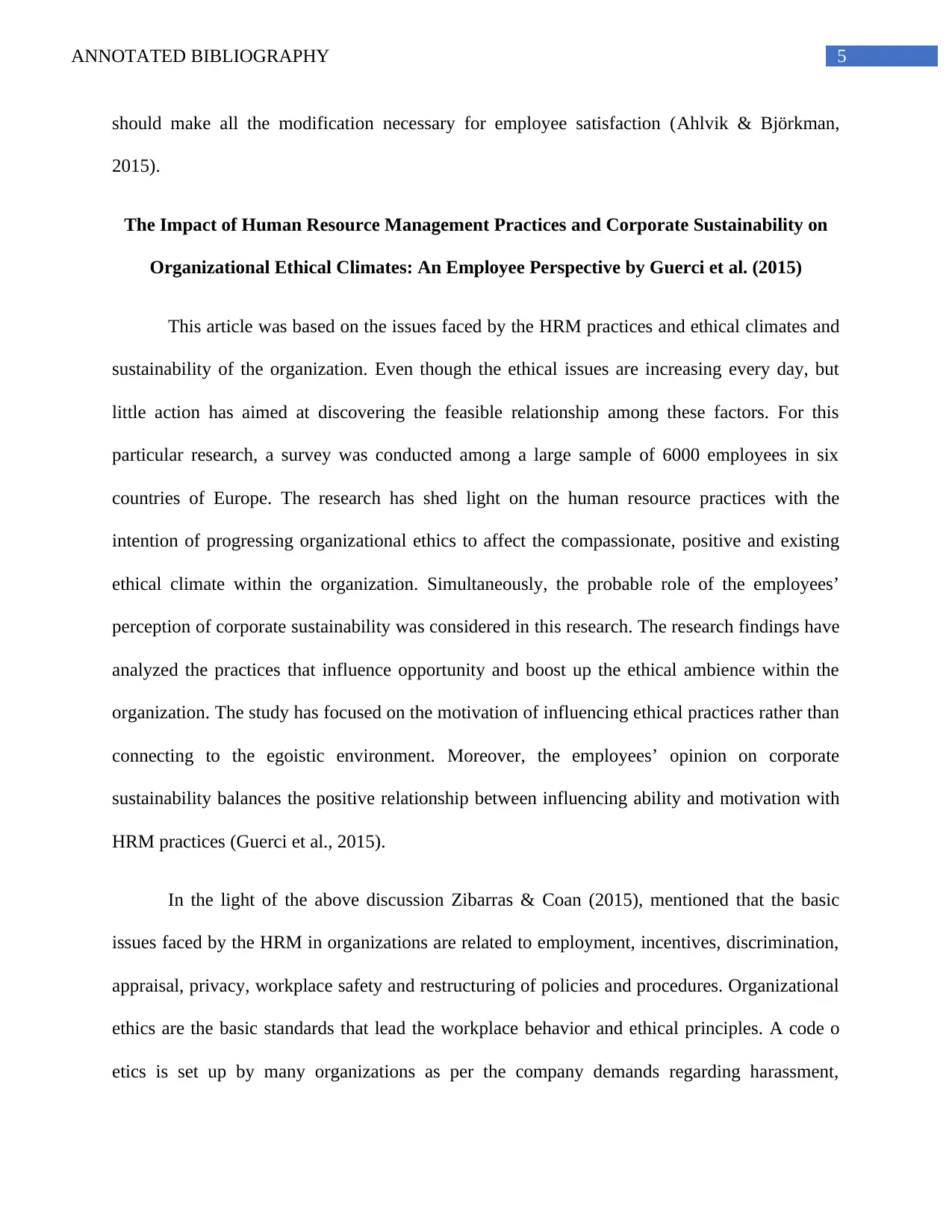
5ANNOTATED BIBLIOGRAPHY
should make all the modification necessary for employee satisfaction (Ahlvik & Björkman,
2015).
The Impact of Human Resource Management Practices and Corporate Sustainability on
Organizational Ethical Climates: An Employee Perspective by Guerci et al. (2015)
This article was based on the issues faced by the HRM practices and ethical climates and
sustainability of the organization. Even though the ethical issues are increasing every day, but
little action has aimed at discovering the feasible relationship among these factors. For this
particular research, a survey was conducted among a large sample of 6000 employees in six
countries of Europe. The research has shed light on the human resource practices with the
intention of progressing organizational ethics to affect the compassionate, positive and existing
ethical climate within the organization. Simultaneously, the probable role of the employees’
perception of corporate sustainability was considered in this research. The research findings have
analyzed the practices that influence opportunity and boost up the ethical ambience within the
organization. The study has focused on the motivation of influencing ethical practices rather than
connecting to the egoistic environment. Moreover, the employees’ opinion on corporate
sustainability balances the positive relationship between influencing ability and motivation with
HRM practices (Guerci et al., 2015).
In the light of the above discussion Zibarras & Coan (2015), mentioned that the basic
issues faced by the HRM in organizations are related to employment, incentives, discrimination,
appraisal, privacy, workplace safety and restructuring of policies and procedures. Organizational
ethics are the basic standards that lead the workplace behavior and ethical principles. A code o
etics is set up by many organizations as per the company demands regarding harassment,
should make all the modification necessary for employee satisfaction (Ahlvik & Björkman,
2015).
The Impact of Human Resource Management Practices and Corporate Sustainability on
Organizational Ethical Climates: An Employee Perspective by Guerci et al. (2015)
This article was based on the issues faced by the HRM practices and ethical climates and
sustainability of the organization. Even though the ethical issues are increasing every day, but
little action has aimed at discovering the feasible relationship among these factors. For this
particular research, a survey was conducted among a large sample of 6000 employees in six
countries of Europe. The research has shed light on the human resource practices with the
intention of progressing organizational ethics to affect the compassionate, positive and existing
ethical climate within the organization. Simultaneously, the probable role of the employees’
perception of corporate sustainability was considered in this research. The research findings have
analyzed the practices that influence opportunity and boost up the ethical ambience within the
organization. The study has focused on the motivation of influencing ethical practices rather than
connecting to the egoistic environment. Moreover, the employees’ opinion on corporate
sustainability balances the positive relationship between influencing ability and motivation with
HRM practices (Guerci et al., 2015).
In the light of the above discussion Zibarras & Coan (2015), mentioned that the basic
issues faced by the HRM in organizations are related to employment, incentives, discrimination,
appraisal, privacy, workplace safety and restructuring of policies and procedures. Organizational
ethics are the basic standards that lead the workplace behavior and ethical principles. A code o
etics is set up by many organizations as per the company demands regarding harassment,
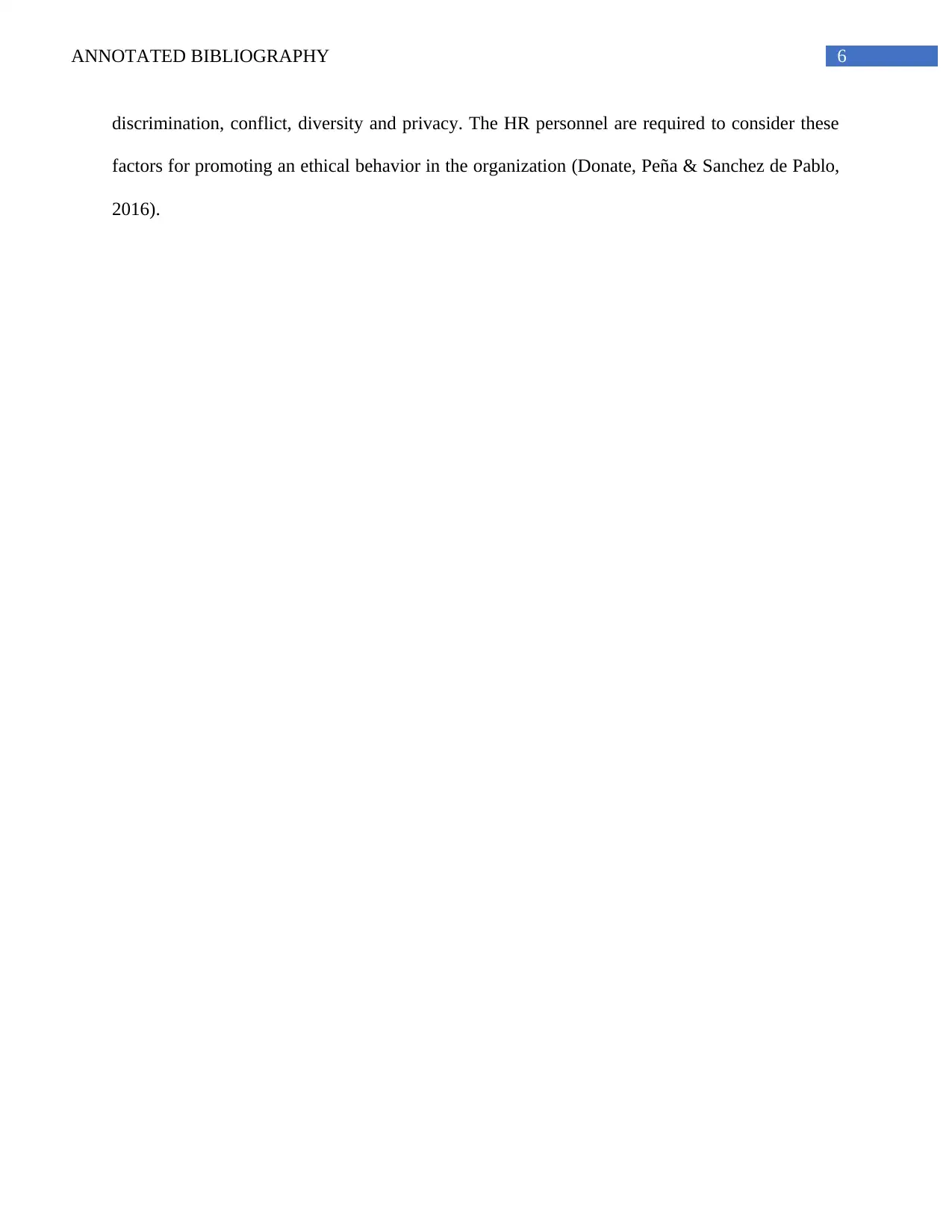
6ANNOTATED BIBLIOGRAPHY
discrimination, conflict, diversity and privacy. The HR personnel are required to consider these
factors for promoting an ethical behavior in the organization (Donate, Peña & Sanchez de Pablo,
2016).
discrimination, conflict, diversity and privacy. The HR personnel are required to consider these
factors for promoting an ethical behavior in the organization (Donate, Peña & Sanchez de Pablo,
2016).
Paraphrase This Document
Need a fresh take? Get an instant paraphrase of this document with our AI Paraphraser
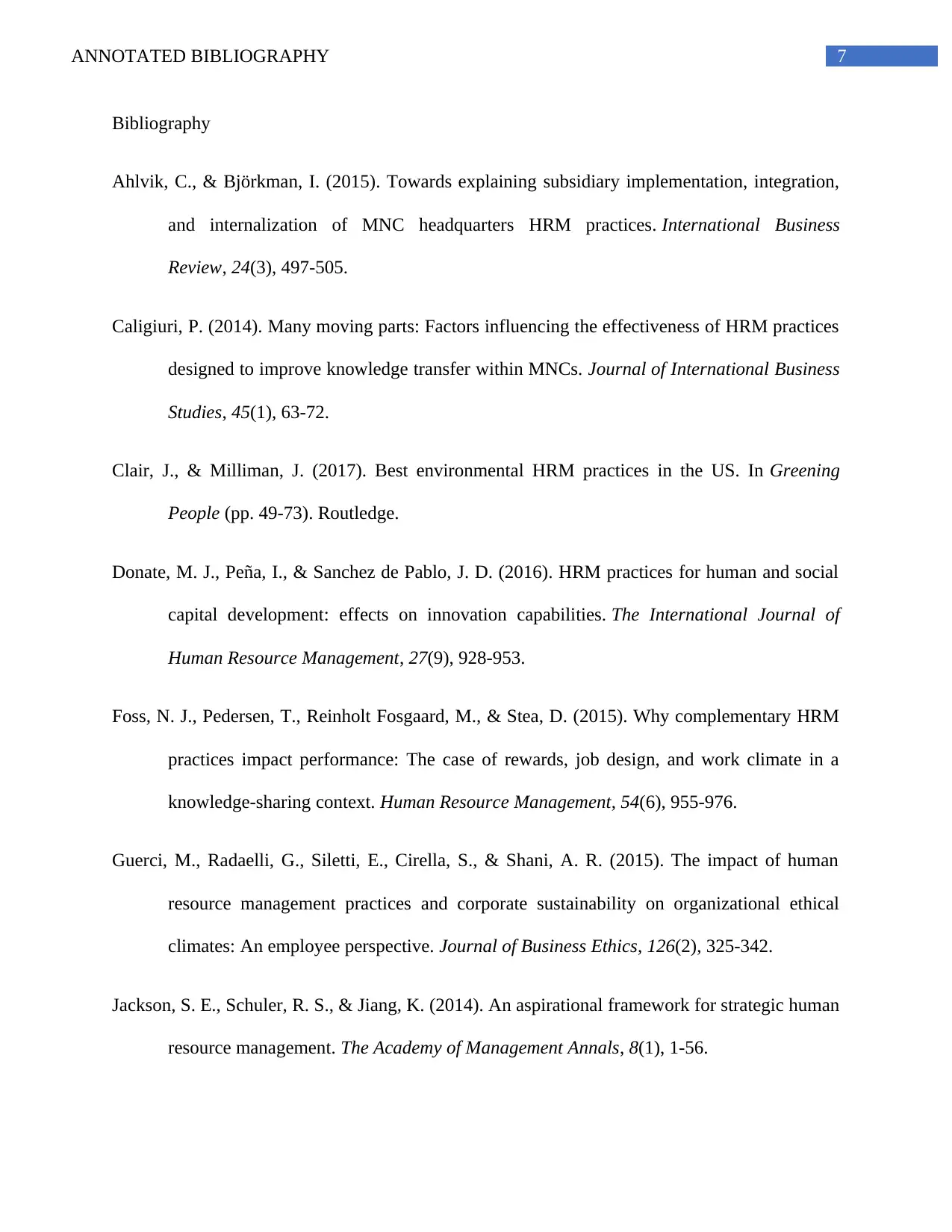
7ANNOTATED BIBLIOGRAPHY
Bibliography
Ahlvik, C., & Björkman, I. (2015). Towards explaining subsidiary implementation, integration,
and internalization of MNC headquarters HRM practices. International Business
Review, 24(3), 497-505.
Caligiuri, P. (2014). Many moving parts: Factors influencing the effectiveness of HRM practices
designed to improve knowledge transfer within MNCs. Journal of International Business
Studies, 45(1), 63-72.
Clair, J., & Milliman, J. (2017). Best environmental HRM practices in the US. In Greening
People (pp. 49-73). Routledge.
Donate, M. J., Peña, I., & Sanchez de Pablo, J. D. (2016). HRM practices for human and social
capital development: effects on innovation capabilities. The International Journal of
Human Resource Management, 27(9), 928-953.
Foss, N. J., Pedersen, T., Reinholt Fosgaard, M., & Stea, D. (2015). Why complementary HRM
practices impact performance: The case of rewards, job design, and work climate in a
knowledge‐sharing context. Human Resource Management, 54(6), 955-976.
Guerci, M., Radaelli, G., Siletti, E., Cirella, S., & Shani, A. R. (2015). The impact of human
resource management practices and corporate sustainability on organizational ethical
climates: An employee perspective. Journal of Business Ethics, 126(2), 325-342.
Jackson, S. E., Schuler, R. S., & Jiang, K. (2014). An aspirational framework for strategic human
resource management. The Academy of Management Annals, 8(1), 1-56.
Bibliography
Ahlvik, C., & Björkman, I. (2015). Towards explaining subsidiary implementation, integration,
and internalization of MNC headquarters HRM practices. International Business
Review, 24(3), 497-505.
Caligiuri, P. (2014). Many moving parts: Factors influencing the effectiveness of HRM practices
designed to improve knowledge transfer within MNCs. Journal of International Business
Studies, 45(1), 63-72.
Clair, J., & Milliman, J. (2017). Best environmental HRM practices in the US. In Greening
People (pp. 49-73). Routledge.
Donate, M. J., Peña, I., & Sanchez de Pablo, J. D. (2016). HRM practices for human and social
capital development: effects on innovation capabilities. The International Journal of
Human Resource Management, 27(9), 928-953.
Foss, N. J., Pedersen, T., Reinholt Fosgaard, M., & Stea, D. (2015). Why complementary HRM
practices impact performance: The case of rewards, job design, and work climate in a
knowledge‐sharing context. Human Resource Management, 54(6), 955-976.
Guerci, M., Radaelli, G., Siletti, E., Cirella, S., & Shani, A. R. (2015). The impact of human
resource management practices and corporate sustainability on organizational ethical
climates: An employee perspective. Journal of Business Ethics, 126(2), 325-342.
Jackson, S. E., Schuler, R. S., & Jiang, K. (2014). An aspirational framework for strategic human
resource management. The Academy of Management Annals, 8(1), 1-56.
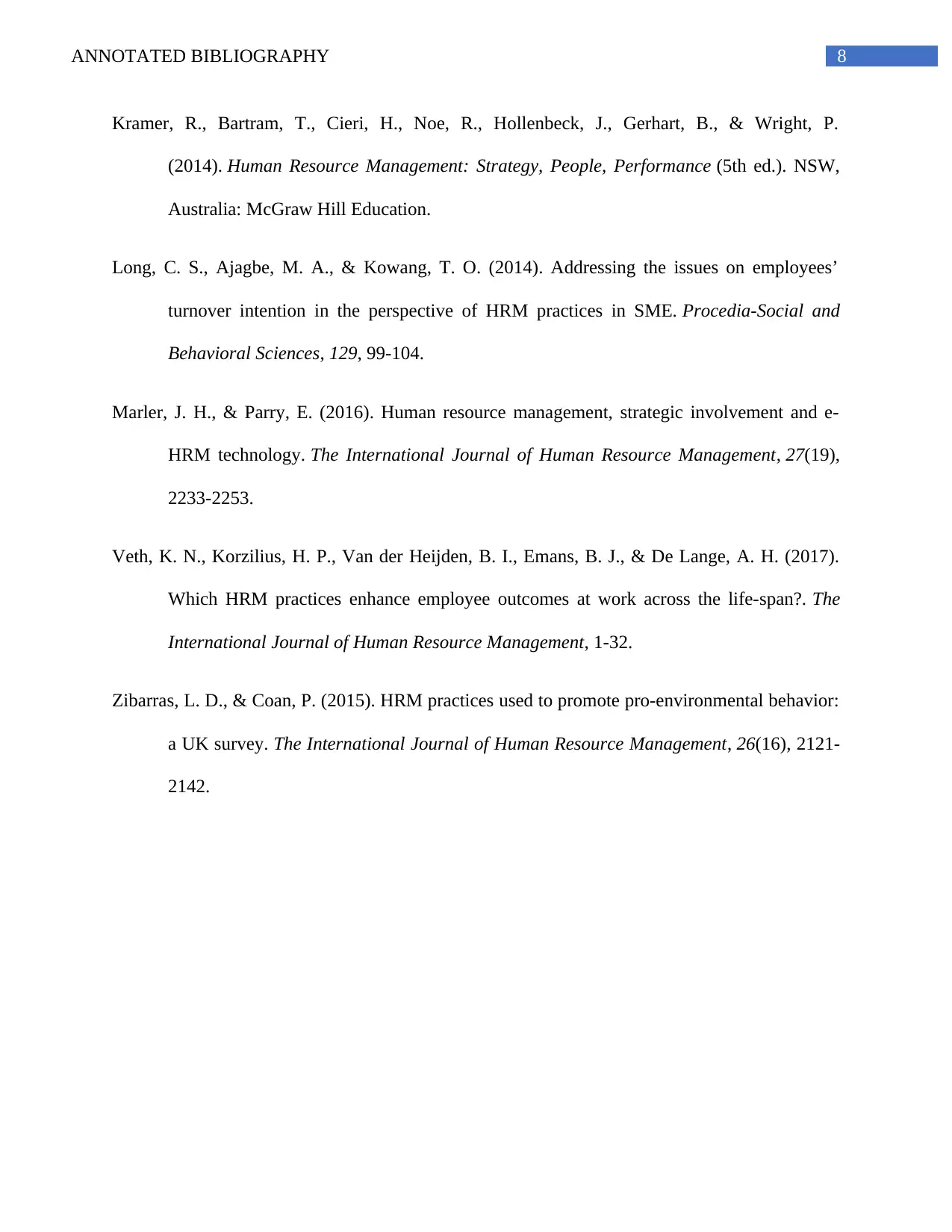
8ANNOTATED BIBLIOGRAPHY
Kramer, R., Bartram, T., Cieri, H., Noe, R., Hollenbeck, J., Gerhart, B., & Wright, P.
(2014). Human Resource Management: Strategy, People, Performance (5th ed.). NSW,
Australia: McGraw Hill Education.
Long, C. S., Ajagbe, M. A., & Kowang, T. O. (2014). Addressing the issues on employees’
turnover intention in the perspective of HRM practices in SME. Procedia-Social and
Behavioral Sciences, 129, 99-104.
Marler, J. H., & Parry, E. (2016). Human resource management, strategic involvement and e-
HRM technology. The International Journal of Human Resource Management, 27(19),
2233-2253.
Veth, K. N., Korzilius, H. P., Van der Heijden, B. I., Emans, B. J., & De Lange, A. H. (2017).
Which HRM practices enhance employee outcomes at work across the life-span?. The
International Journal of Human Resource Management, 1-32.
Zibarras, L. D., & Coan, P. (2015). HRM practices used to promote pro-environmental behavior:
a UK survey. The International Journal of Human Resource Management, 26(16), 2121-
2142.
Kramer, R., Bartram, T., Cieri, H., Noe, R., Hollenbeck, J., Gerhart, B., & Wright, P.
(2014). Human Resource Management: Strategy, People, Performance (5th ed.). NSW,
Australia: McGraw Hill Education.
Long, C. S., Ajagbe, M. A., & Kowang, T. O. (2014). Addressing the issues on employees’
turnover intention in the perspective of HRM practices in SME. Procedia-Social and
Behavioral Sciences, 129, 99-104.
Marler, J. H., & Parry, E. (2016). Human resource management, strategic involvement and e-
HRM technology. The International Journal of Human Resource Management, 27(19),
2233-2253.
Veth, K. N., Korzilius, H. P., Van der Heijden, B. I., Emans, B. J., & De Lange, A. H. (2017).
Which HRM practices enhance employee outcomes at work across the life-span?. The
International Journal of Human Resource Management, 1-32.
Zibarras, L. D., & Coan, P. (2015). HRM practices used to promote pro-environmental behavior:
a UK survey. The International Journal of Human Resource Management, 26(16), 2121-
2142.
1 out of 9
Related Documents
Your All-in-One AI-Powered Toolkit for Academic Success.
+13062052269
info@desklib.com
Available 24*7 on WhatsApp / Email
![[object Object]](/_next/static/media/star-bottom.7253800d.svg)
Unlock your academic potential
© 2024 | Zucol Services PVT LTD | All rights reserved.





